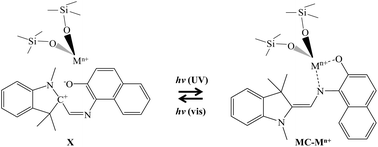Chelation ability of spironaphthoxazine with metal ions in silica gel†
Abstract
Spironaphthoxazine (SNO) and three metal ions, Mg2+, Zn2+, and Al3+, were dispersed in

* Corresponding authors
a
Department of Environmental Science and Technology, Faculty of Engineering, Shinshu University, 4-17-1 Wakasato, Nagano 380-8553, Japan
E-mail:
nishiki@shinshu-u.ac.jp
Fax: +81-26-269-5550
Tel: +81-26-269-5536
Spironaphthoxazine (SNO) and three metal ions, Mg2+, Zn2+, and Al3+, were dispersed in

 Please wait while we load your content...
Something went wrong. Try again?
Please wait while we load your content...
Something went wrong. Try again?
H. Nishikiori, K. Teshima and T. Fujii, Photochem. Photobiol. Sci., 2012, 11, 1164 DOI: 10.1039/C2PP05345D
To request permission to reproduce material from this article, please go to the Copyright Clearance Center request page.
If you are an author contributing to an RSC publication, you do not need to request permission provided correct acknowledgement is given.
If you are the author of this article, you do not need to request permission to reproduce figures and diagrams provided correct acknowledgement is given. If you want to reproduce the whole article in a third-party publication (excluding your thesis/dissertation for which permission is not required) please go to the Copyright Clearance Center request page.
Read more about how to correctly acknowledge RSC content.
 Fetching data from CrossRef.
Fetching data from CrossRef.
This may take some time to load.
Loading related content
